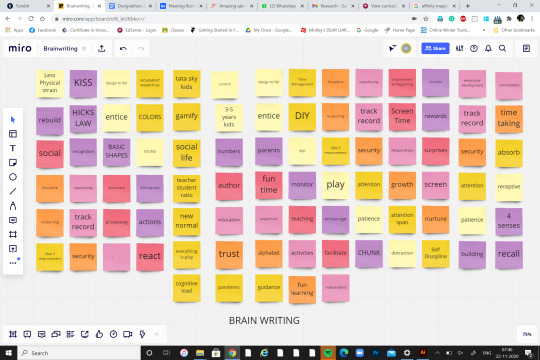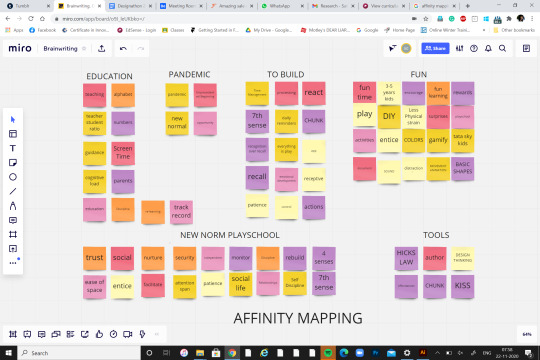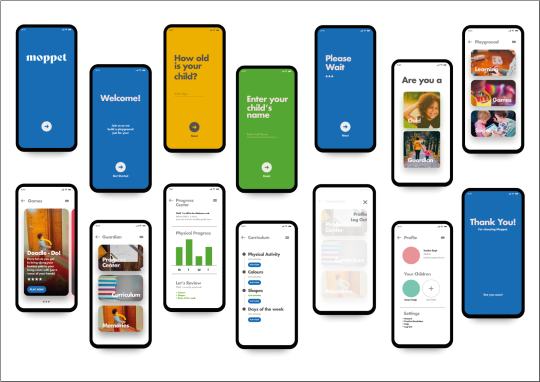Don't wanna be here? Send us removal request.
Text
Ohh, wait..before we leave,
here's our gift to you, Earthlings.
Adios! #happystudying ;)
0 notes
Text
With this,
Satan's taking your leave now.
Go read our blog post.
See you next Designathon, Earthlings!
0 notes
Text
Satan’s Moppet
The COVID-19 pandemic has brought a change that is here to stay.
The world is constantly adapting to this so-called ‘new normal’. Virtual schooling is a way of life now. But, in this hustle to adapt, playschoolers, i.e, children aged 3-5 years are being overlooked. Through our project, 'Moppet', we aim to see the playschool education with a new eye, to redefine it using gamification, in order to help preschoolers grow holistically.

A. EMPATHISE
1. Secondary Research
- Market trends of UX-UI app designs trends specifically for kids, ranging from hero pictures, colour theory for kids, big typography, compelling storytelling, imagery used, trending use of gradients and quirky illustrations, creative usage of split-screens, stress on universal UX writing, re-imagining Information Architecture to be simpler for kids etc.
- Competition analysis of existing apps, websites and services for kids that cater to providing education for example Kiddipedia, FlintoBox, FunBrain, Learninggamesforkids, A Fine Parent, MindSeed, Kangaroo Kids etc.
2. Primary Research
- This step was followed to quickly gather information from various stakeholders ranging from kids, parents or primary caregivers who would be using the app to gain insight about the existing educational curriculum in schools, condition of education during the pandemic. Information was gathered on people’s opinions to analyse what are their pain points, desires, wants and needs regarding the educational infrastructure during the pandemic.
3. Interviews (Non-Directed, Focus Groups) and Brain-Writing
- We conducted a brain writing session within the team using a collaborative tool called Miro, to put out keywords from our primary and secondary research and understanding of the problem at hand.
- General discussion sessions and interviews were conducted with few stakeholders that gave us insights on the problems people are facing and their suggestions for solving the same.

Inference
The research gave us valuable insights that strengthened our understanding of the problem at hand and made it’s picture clearer with every passing stage. We inferred that due to the pandemic, classes have shifted online in urban areas, students enrolled in various schools and colleges have adapted to the new normal, but, it made us realise that those kids that are not yet enrolled in the formal educational infrastructure in India, namely preschoolers, or kids ranging from the age of 3-5 years have been left out in the process. The parents are grappling with balancing work at home and managing kids who in a pre-covid setting would have been dropped off and picked off from their playschool during the regular work hours. It has led to micro-management of kids and exhaustion in parents. For those play-schoolers who are attempting to adapt to the new normal, the risk of high screen time is a predominant fear in parents and primary caregivers, along with the lack of peer-to-peer relationship development or physical activities that the child might have done in a school setting. The pre-school curriculum in the heyday of the pandemic requires a shift. One that not only caters to their educational development but, emotional and physical, as well.
B. DEFINE
1. Affinity Mapping
Based on our secondary, primary research and brain-writing, we sorted our keywords into affinity mapping to organise sets of relevant data into ‘super-groups’ that helped us organise and club our thoughts and give them a structure to identify features that could be integrated in our solution.

2. POV Statement
We then used the User + Need + Insights matrix to formulate our point of view statement, i.e, 3-5 year old preschool kids need a way to develop their physical, emotional and educational learning at home because of the pandemic.

Target Audience
Our target group primarily consists of playschool kids aged 3-5 years, their parents, guardians or any other primary care-givers. The tool would also be pitched to schools to inculcate the same as a part of their curriculum.
Inference: This exercise helped us realise the problem set and formulate our design brief.
Design Brief
‘Redefining preschool curriculum using gamification’
C. IDEATE
1. Design Solution
On the basis of our research and understanding of the problem set and analysis of competition, we arrived at a solution of refining the existing play school curriculum in India, w.r.t, to the new normal that one has to adapt to during the pandemic.
We observed that the dearth of schooling options for play-schoolers during the pandemic can be bridged by bringing the existing playschool curriculum from a school setting to a virtual setting but with the adoption of certain new developments that were previously non-existent. According to our research, traditionally play schools in India have become a place for kids to play together along with basic learning of numerics or alphabets. This has been disrupted, as online modes of education during the pandemic are prevalent for Kindergarten to university or college students, hence, playschools are overlooked. Therefore, the real problem gets solved not only by bringing playschools online, as there are a plethora of existing curriculums which can be brought online to parents and kids. But, by bringing playschools online, along with the addition of our suggestions of games for ‘emotional’ and ‘physical’ development, along with the existing set of ‘educational development’ curriculum in schools, that would help the child grow holistically in a pandemic struck world where the child is devoid of ways to form emotional bonds or develop physical growth which would have been previously possible in a classroom setting.
The proposed refinement of curriculum could be done by addition of games, for eg.
Emotional Development: These games are devised at helping the child collaborate with his peers in a pandemic struck world, build relationships, enhance friendships and develop emotional bonds.
a) Spin-the-bottle: The child can play this game with a computer setting or with his classmates or society friends, where they spin the bottle by clicking on a button on their device and the two people who get a chance, ask one another questions that they can pick from the options they get.
b) Moppet Pictionary: The children play a pictionary game together, by drawing out from a given set of words on their screen and drawing the same on a paper and letting the audience guess the same.
Physical Development: These games are devised at developing the physical growth in a child aiding in locomotion, movement, physical activity, strength training etc in order to keep a child fit and active.
a) Treasure Digger: Kids essentially are used to play in their rooms and their sleeping off when tired or moving on to another activity, this would be replaced by an exercise in their curriculum which can be working on the reverse cycle of collecting and assembling their toys back into a box to inculcate responsibility and get them to move around and develop themselves physically.
b) Animal Walk: The child will be shown movements of different animals and has to mimic the same. If done correctly, the child moves on to next animal in the module.
c) DanceWhiz: The child has to copy the dance moments shown on screen and has to dance to the beats in an arcade game setting. The dance would be on popular rhymes and riddles of playschools like twinkle twinkle, humpty dumpty etc.
d) AR Doodle: Using augmented reality, the child has to draw letters form the alphabet as required in the task through body gestures.
1. Information Architecture

Branding of Moppet
Colours can deeply emote a person in ways which only they can. Kids and their guardians being the primary users of the app, we made sure to cater to both the groups. Warm, playful shades of yellow, complemented by cooler shades of blue and green were selected. Backed by neutrals of dark grey and white.
Warmer tones give out a sense of playfulness, joy and appeal especially for kids. We made sure we get to it right from the on-boarding journey.
Cooler shades of blue, green stand for trust, growth, fulfilment and security. We made sure the most critical progress metrics and data made use of these colours.

This helps in accentuating the highlights of a child’s progress throughout their playful journey. The project was named ‘Moppet’ meaning an endearing, sweet child.
D. PROTOTYPING
1. Low-Fidelity Prototype: Collaboratively low-fidelity prototypes were made by Team Satan on Miro.

2. High-Fidelity Prototyping

E. TESTING
User-Testing
The prototype was tested with kids and parents to check how they use the solutions, to get their insights on their interaction with the solution, to check the time spent of devices to use the suggested solutions, to see them learn while they play and gauge the amount of parental supervision needed etc.

Hope you like ‘Moppet’. Time for Satan to go!
0 notes
Text
Maintain caution. Satan's heirs are progressing in their journey to Earth.
0 notes
Text
The best way to predict the future is to create it. Stay tuned!
0 notes
Text
Mini Challenge 3

They said it could be a team of 4 🤭🐕
0 notes
Text
How? Now? Wow?!
Team Satan breaking hell while discussing their how, now and wow of their plan to rescue Earthlings!🌏💞
0 notes
Text
Satan said, "Break over now, get back to research!"



0 notes
Text
The key to good design is positivi-tea 🍵

#satanteabreak #minichallenge2
0 notes
Text
Satan's Brain Vomit
Team Satan using brain writing weaponry to save the pandemic struck Earth.
0 notes
Video
tumblr
Mini Challenge 1
When broke lose all hell, Upon us the pandemic befell,
Satan cried, and sent his heir, Senjuti, Abhishek and Tanya to help those in despair.
That's how, in Designathon 2020 they participate, Contrary to popular belief, this Satan says, "Spread love, no hate." ;)
0 notes

